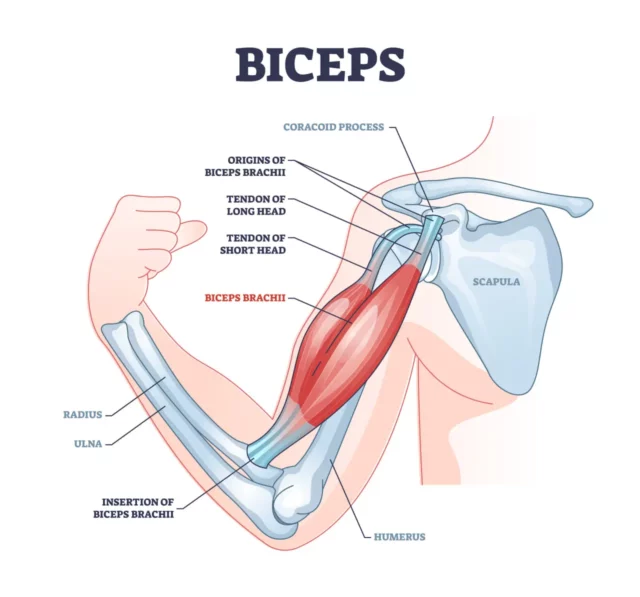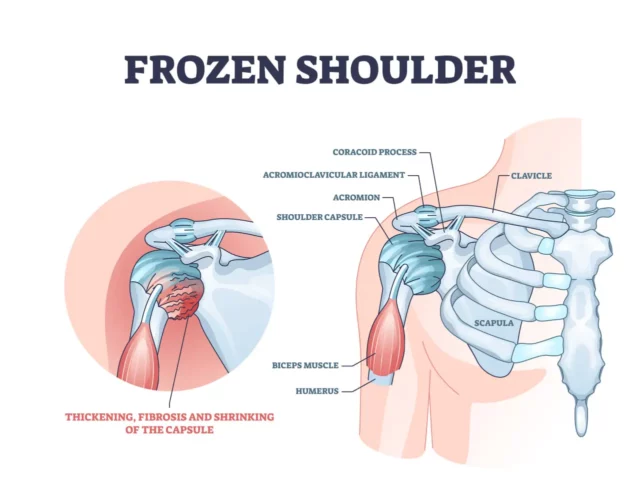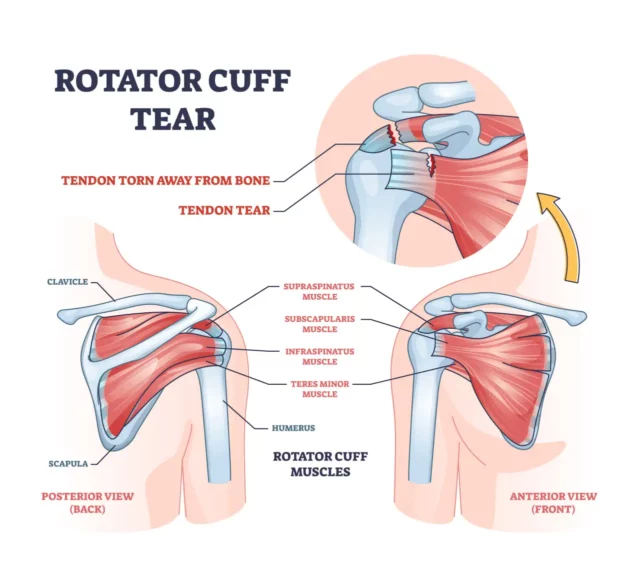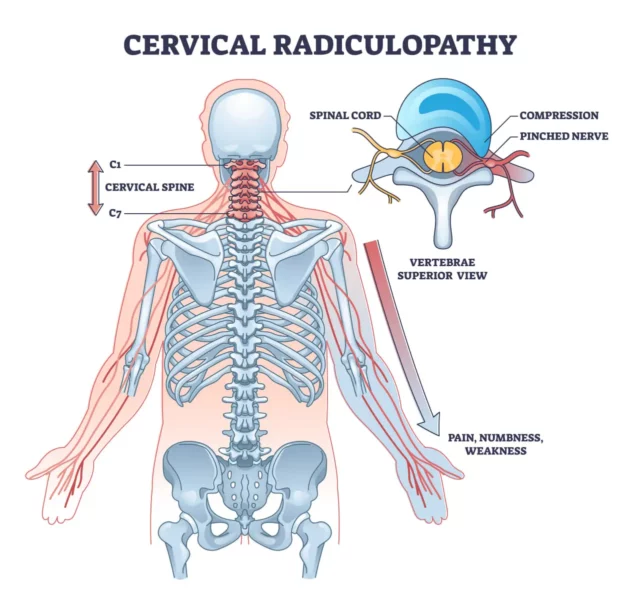It’s common to experience sore biceps after an intense workout. However, when the pain becomes persistent or chronic, interferes with daily activities, or affects athletic performance, seeking appropriate treatment and diagnosis is essential. Sometimes, the pain might indicate nothing more than an overworked muscle. However, it can also be a sign of a more serious underlying condition, such as tendonitis, a frozen shoulder, or rotator cuff issues.
At NextPain Care, we focus on restoring the health of your biceps tendons using a comprehensive approach. Our evidence-based treatments target pain and discomfort associated with inflammatory conditions while addressing all factors contributing to your pain. Let’s explore how our approach can help below.
What Pain In The Biceps Tendons Feels Like
Tendons are strong bands of connective tissue that link the bones of a joint to a muscle, playing a vital role in enabling movement and preventing abnormal or excessive motions that may lead to injury.
The upper end of the biceps muscle has two tendons that attach it to the shoulder joint:
- The tendon of the long head attaches to the glenoid (the shoulder socket).
- The tendon of the short head attaches to the coracoid process, a bump on the shoulder blade.
The lower end of the biceps muscle has one tendon, the distal biceps tendon, which attaches it to the radius (the bone in your forearm) at the elbow.
These tendons are incredibly resilient and provide the arm with an extraordinary range of motion. However, certain lifestyle factors, activities, and health conditions can cause tears and inflammation, thus leading to chronic pain.
Biceps tendon pain can feel different, depending on what’s causing it. However, if it derives from tears, inflammation, or shoulder problems, you are likely to experience these symptoms:
- Chronic pain that radiates from the top of your upper arm or shoulder
- Sudden pain at the time of injury, or dull, aching pain
- An audible “popping” sound at the time of injury
- Tenderness and weakness at the shoulder (especially around the anterior aspect of the joint) or elbow
- Stiffness in the shoulder and reduced range of motion
- Weakness when lifting objects over your head or during motions like throwing
- Trouble turning the palm or arm up or down
- Bruising
- A visible bulge above the elbow (known as Popeye’s sign)
Different Factors Leading To Biceps Tendon Pain
While biceps tendon pain can affect anyone at any stage of life, some demographics are at higher risk. Athletes who regularly perform overhead and throwing motions may place undue stress and biomechanical demands on the shoulder and bicep, increasing their risk of injuries.
Other risk factors include:
- Injury or trauma: Contact and non-contact trauma, such as collisions or falling on an outstretched arm, can cause the tendon to stretch beyond its capacity or in an abnormal direction. Injuries such as fractures or shoulder dislocations can also pull on connected tendons, leading to tears.
- Normal aging: The aging process causes tendons to become stiffer and less capable of withstanding forces, making injuries more likely.
- Overuse or repetitive movements: Excessive forces on the biceps tendons can cause micro-tears. Over time, this damage can progress to serious tears, inflammation, and irritation. Repetitive movements that affect the biceps tendons include overhead motions and lifting.
- Poor posture: Poor posture can affect the mechanics of the shoulder and prevent loads from being distributed evenly. As the body compensates, areas of the tendons may be placed under undue stress, increasing the risk of injury.
Different Conditions Associated With Tendon Biceps Pain
While inflammation is the most likely culprit of pain in the bicep, several conditions may cause this symptom. Below, we’ll look at the most common conditions.
Tendonitis
Tendonitis refers to inflammation or irritation of a tendon and is a form of tendinopathy (a condition of the tendon). This condition can be triggered by a sudden injury or result from repetitive movements and overuse, applying forces that exceed the tendon’s strength. These forces can lead to irritation and micro-tears, fueling further inflammation and causing long-lasting pain. Common causes of tendonitis include excessive workouts, heavy lifting, and activities that involve frequent and forceful arm movements.
Although tendonitis can affect any tendon of the bicep, it is more common in the long head. In this case, the inflammation can extend to or from the rotator cuff complex, leading to rotator cuff tendonitis.
Biceps tendonitis can affect the shoulder or the elbow, but it is unusual to have tendonitis in both places simultaneously. In the shoulder, biceps tendonitis can occur along with rotator cuff tendonitis, as it is part of the rotator cuff complex. Tendonitis remains a significant issue for athletes, accounting for 30% of all overuse injuries. In the upper body, the biceps tendons are the most frequently affected.
Frozen Shoulder
Frozen shoulder, also known as adhesive capsulitis, is characterized by stiffness and pain in the shoulder joint, which usually develops gradually over time. The causes of frozen shoulders aren’t fully understood, but it is thought that hormones, immune system response, and lack of joint use (e.g., during periods of immobilization after injuries and surgeries) might play a role.
A frozen shoulder severely inhibits the shoulder’s range of motion, making movements stiff and painful. When you attempt to move the shoulder beyond its restricted range, the biceps tendon, which is attached to the shoulder joint, is placed under unusual stress. This can lead to further inflammation of the tendon, tears, and pain. Studies have shown that tests for biceps tendinopathy are often positive in those with frozen shoulders.
Rotator Cuff Injuries
Rotator cuff injuries are a common issue among both athletes and non-athletes. They occur when the tendons or muscles around the shoulder joint are damaged, torn, or irritated, often due to repetitive overhead motions or sudden forceful trauma, such as a motor vehicle collision.
If you’re experiencing biceps tendon pain, a rotator cuff injury might be the root cause. The biceps tendon runs through the rotator cuff, and any discomfort or inflammation in the cuff can cause pain and inflammation to radiate down into the bicep.
Studies have shown that tears in the long head of the biceps tendon are often associated with rotator cuff tears. Conversely, in people with rotator cuff tears, the long head tendon can be a significant source of pain.
Tendon Tears
Although tears in the biceps tendon are not extremely common, they are often the second most likely cause of biceps tendon pain after tendonitis. Tears occur when the tendon experiences sudden trauma or is strained due to overexertion, repetitive heavy lifting, or a sudden, unexpected movement.
A torn biceps tendon is often accompanied by a sharp pain in the upper arm and a distinct popping sound or sensation at the time of injury. After the initial pain, the tear and the resulting inflammatory process can lead to swelling, weakness, difficulty in moving the arm in certain directions, and a feeling of instability in the shoulder or elbow. The intensity of these symptoms largely depends on the severity of the tear. While mild tears can be treated through self-care strategies and activity modifications, a severely torn tendon can prevent you from moving your arm and may require medical care.
Cervical Radiculopathy
Cervical radiculopathy is a condition that occurs when the nerves around the neck are damaged, irritated, or entrapped. It can result from aging joints in the neck area or bulging intervertebral discs. These conditions narrow the space in the cervical spine that houses the nerves, preventing them from working properly. This can lead to disruptions in the transmission of pain, sensation, and movement signals to and from the brain.
Some of the nerves in the cervical spine branch off to innervate the shoulder, bicep, and forearm. When these nerves are damaged or entrapped, you may experience sharp pain in your biceps tendon, along with numbness, tingling sensations, and weakness.
Biceps Tendon Rupture
A rupture is a form of tendon tear that occurs when the tendon becomes completely detached from the nearby bone or muscle. It can happen due to a traumatic event or a non-contact injury, often as a result of excessive force on the biceps tendon when the elbow is bent. A ruptured tendon typically causes severe pain, bruising, weakness, instability, and a reduced range of motion.
Ruptures can affect the biceps tendons attached to the shoulder joint, but they may also occur in the distal attachment at the elbow. Ruptures of the distal biceps tendon are often characterized by Popeye’s sign, a visible and pronounced bulging in the bicep, and they usually require surgery.
Diagnosing Tendon Pain
Diagnosing the root cause of tendon pain can be challenging because it is a non-specific symptom, common to many musculoskeletal conditions, and there is no single diagnostic test for biceps tendon pain.
However, your doctor may use several diagnostic tools to identify the cause and choose an adequate treatment plan. Some of these tests include:
- A review of your symptoms and medical history.
- A physical examination, during which your doctor may palpate the painful area and assess the range of motion of the shoulder and elbow, the strength of your muscle, signs of inflammation, and tell-tale symptoms like Popeye’s sign.
- A review of your daily activities, especially if you are an athlete involved in contact sports or regularly practice overhead throwing motions.
- If necessary, imaging tests like an X-ray or MRI might be used to provide a clearer picture of the inner aspect of the biceps area.
When To Seek Medical Attention
In most cases, biceps tendon pain stems from a mild strain or tear, which can be addressed with at-home care. However, this symptom can sometimes indicate a more severe underlying condition. You should seek medical attention if:
- The pain is not going away.
- The pain worsens over time.
- The reduced range of motion and discomfort are interfering with your daily life.
- You experience sudden trauma, intense pain, or inability to move your arm.
- You have other symptoms, such as shortness of breath and chest pain, which can indicate an ongoing heart attack.
- The pain is accompanied by severe numbness, tingling sensations, or severe weakness.
Conventional Methods For Relieving Tendon Discomfort
Biceps tendon pain is typically treated using conservative methods, such as NSAIDs and steroid injections. These treatments can address the root cause of your symptoms and be effective in relieving pain. In severe cases, such as a completely torn or ruptured tendon, your doctor may recommend surgery. Below, we’ll look at the most commonly used treatment plans for biceps tendon pain.
Nonsteroidal Anti-Inflammatory Medications (NSAIDs)
NSAIDs, or non-steroidal anti-inflammatory medications, are a class of medication used to help reduce inflammation and pain. These medications work by blocking the COX enzyme, thus limiting the production of chemicals called prostaglandins, which trigger inflammation, pain, and fever symptoms. NSAIDs can effectively alleviate the inflammation associated with biceps tendon pain.
It is important to use NSAIDs as directed by your healthcare provider to manage symptoms effectively and minimize potential side effects. For many patients, NSAIDs offer a safe and effective option for managing pain and inflammation associated with biceps tendon issues.
Steroid Injections
Steroid injections, also known as corticosteroid injections, are another treatment option for managing inflammation linked with biceps tendon pain. These injections work by mimicking the effects of the cortisol hormone, which the body produces naturally in response to stress. These hormones suppress the immune response and reduce inflammation, providing relief from biceps tendon pain.
Surgical Treatment
If you have suffered a severe tendon injury, such as a complete tear or rupture, you may need to undergo surgery to restore your arm and shoulder function. The most common surgical procedures used in these cases include:
- Biceps tenodesis: During this surgery, the inflamed or damaged part of the biceps tendon is removed, and the remaining healthy portion is reattached to the humerus bone, thereby reducing pain and restoring function.
- Biceps tenotomy: During this procedure, the surgeon will cut the tendon that attaches the biceps muscle to the shoulder. This reduces the tension and, in turn, tendon irritation, which provides relief from pain.
- Rotator cuff repair: This surgical procedure is conducted to fix tears in the shoulder’s rotator cuff and alleviate any related discomfort, including biceps tendon pain. Depending on what components of the rotator cuff are affected, the surgeon may reattach parts of the torn tendon to the bone.
After a surgical intervention, you are likely to need a rehabilitation period to regain full function and strength.
NextPain Care’s Approach To Managing Tendon Pain
Experiencing biceps tendon pain can be frustrating. When it indicates a more serious underlying condition, this symptom can become life-limiting, affecting your personal, professional, and athletic lives. The situation is often complicated by the fact that biceps tendon pain can become chronic.
Electroanalgesia
Electroanalgesia is a pain management technique that uses high-pulse electrical current to ease pain, boost blood circulation, improve mobility, and induce...
IV Therapy
IV nutritional therapy, or intravenous therapy, involves administering vital nutrients directly to the bloodstream through an IV. This type of treatment bypasses the digestive system, allowing for maximum absorption and utilization of nutrients by the...
Chronic Pain Support & Counseling
Lifestyle counseling for pain management involves identifying, assessing, and modifying lifestyle factors that contribute to an individual's pain. Factors such as nutrition, physical activity, stress, sleep quality and quantity, and alcohol consumption can...
"Treatment options are tailored to your individual needs, and availability may vary based on factors such as location and insurance. We’re here to guide you through the possibilities and help determine the best course of action for your journey to relief and recovery."
Serious Implications Of Ignoring Biceps Tendon Pain
Sometimes, it may seem easy to ignore your symptoms and rely on painkillers to manage them. However, this choice can allow a more serious underlying condition to go untreated, leading to a host of complications.
The most common problem you may face is chronic tendonitis, a persistent inflammatory condition that can cause permanent damage to the tendon. You might also experience a loss of strength and mobility in the affected arm, impacting your daily activities. In some severe cases, untreated biceps tendon pain might even result in a complete biceps tear, which requires surgical intervention.
We Manage Conditions Causing Bicep Tendon Pain

Frozen Shoulder Pain Treatment
Frozen shoulder, or adhesive capsulitis, is a condition characterized by inflammation of the shoulder joint capsule, leading to pain, stiffness, and restricted range of motion. This condition can significantly impact daily activities and overall quality of...
Alleviate Arm Discomfort And Improve Your Quality Of Life
When biceps tendon pain becomes chronic, it can begin to affect all aspects of your life. If left untreated, this problem can lead to disability, preventing you from working or engaging in sports. The approach at NextPain Care offers a method designed to support musculoskeletal health and improve overall quality of life.
Feeling discomfort in your bicep tendon? Tendonitis could be the culprit.




